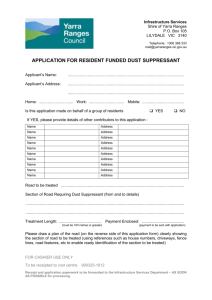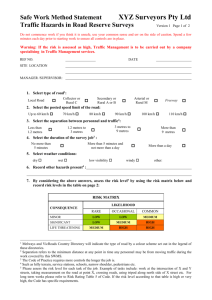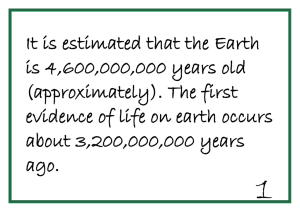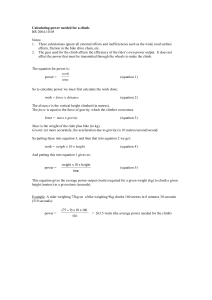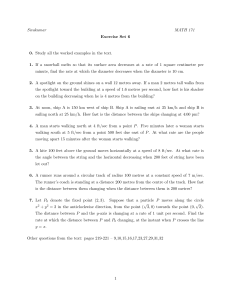Document 12731449
advertisement
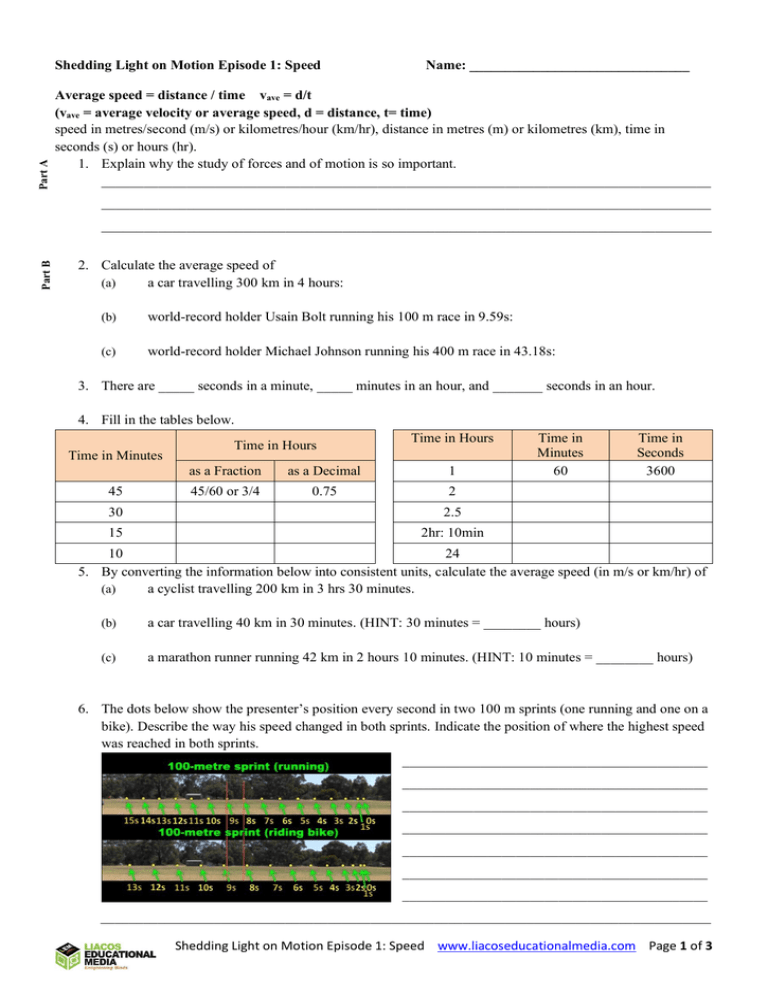
Part A Shedding Light on Motion Episode 1: Speed Name: _______________________________ Average speed = distance / time vave = d/t (vave = average velocity or average speed, d = distance, t= time) speed in metres/second (m/s) or kilometres/hour (km/hr), distance in metres (m) or kilometres (km), time in seconds (s) or hours (hr). 1. Explain why the study of forces and of motion is so important. ______________________________________________________________________________________ ______________________________________________________________________________________ Part B ______________________________________________________________________________________ 2. Calculate the average speed of (a) a car travelling 300 km in 4 hours: (b) world-record holder Usain Bolt running his 100 m race in 9.59s: (c) world-record holder Michael Johnson running his 400 m race in 43.18s: 3. There are _____ seconds in a minute, _____ minutes in an hour, and _______ seconds in an hour. 4. Fill in the tables below. Time in Minutes 45 Time in Hours Time in Hours as a Fraction as a Decimal 1 45/60 or 3/4 0.75 2 30 2.5 15 2hr: 10min Time in Minutes 60 Time in Seconds 3600 10 24 5. By converting the information below into consistent units, calculate the average speed (in m/s or km/hr) of (a) a cyclist travelling 200 km in 3 hrs 30 minutes. (b) a car travelling 40 km in 30 minutes. (HINT: 30 minutes = ________ hours) (c) a marathon runner running 42 km in 2 hours 10 minutes. (HINT: 10 minutes = ________ hours) 6. The dots below show the presenter’s position every second in two 100 m sprints (one running and one on a bike). Describe the way his speed changed in both sprints. Indicate the position of where the highest speed was reached in both sprints. ___________________________________________ ___________________________________________ ___________________________________________ ___________________________________________ ___________________________________________ ___________________________________________ ___________________________________________ ______________________________________________________________________________________ Shedding Light on Motion Episode 1: Speed www.liacoseducationalmedia.com Page 1 of 3 7. What is the difference between average speed and actual (also called “instantaneous”) speed? ______________________________________________________________________________________ ______________________________________________________________________________________ ______________________________________________________________________________________ 8. A 20 km car trip takes half an hour. What is the car’s average speed in the trip and how might the car’s instantaneous speed have changed over the half hour? ______________________________________________________________________________________ ______________________________________________________________________________________ ______________________________________________________________________________________ 9. A bike is moving at a speed of 8 m/s. Fill in the table below. Time (seconds) 0 1 2 3 10 20 Distance Travelled (metres) 0 10. Technically, to specify an object’s velocity, you need to say its __________________ and its ____________________. 11. If vave = d/t, then d = ___________________________. 12. If vave = d/t then t = ____________________________. 13. Calculate the distance you would travel if you moved at: (a) 100 km/hr for 8 hours (b) 6 m/s for 2 seconds (c) 6 m/s for 2 minutes (d) 6 m/s for 2 hours (e) 50 km/hr for 30 minutes (Hint: 1500 km is wrong) (f) 60 km/hr for 2 hours (g) 60 km/hr for 1 hour (h) 60 km/hr for 1 minute (i) 60 km/hr for 1 second 14. Calculate the time it would take: (a) a car to travel 900 km at 100 km/hr. (b) a boat to travel 200 m at a speed of 20 m/s. (c) a 300,000 km/s light beam to get to the moon 378,000 km away. (d) a 330 m/s sound wave to travel 1 km. (e) a 300,000 km/s light wave to travel 1 km. 15. Calculate… (a) The speed of a Melbourne Cup horse which runs the 3200 m horse race in 3 minutes and 16 seconds. (write down the appropriate equation and then perform the calculations) Equation: _______________ The time that it will take a truck to travel 60 km at 40 km/hr. Equation: _______________ (b) The distance a helicopter will travel if it moves at a speed of 30 m/s for 20 seconds. Equation: _______________ (c) Shedding Light on Motion Episode 1: Speed www.liacoseducationalmedia.com Page 2 of 3 Part C 16. (a) 10 km = _______________ metres. 1 hour =_______________ seconds (b) 10 km/hr = _______________m/ _______________s = ____________m/s 17. Fill in the graphic on the right and then convert the following speeds from km/hr to m/s or vice versa: m/s (a) 100 km/hr (e) 6 m/s (b) 20 m/s (f) 330 m/s (the speed of sound in 0°C air) (c) 60 km/hr (g) 263 km/hr (the fastest ever tennis serve) (d) 10 m/s (h) 1m km/hr 18. A car is travelling at 70 km/hr when the driver sees a person step out onto the road in front. If the driver’s reaction time is 0.22 seconds, calculate the distance that the driver travels during this time period. (Hint: watch your units.) 19. What are some of the things you should and shouldn’t do while driving to maximise your chance of avoiding accidents. ______________________________________________________________________________________ ______________________________________________________________________________________ Part D ______________________________________________________________________________________ 20. Describe how you can use a digital camera to measure the duration of an event. ______________________________________________________________________________________ ______________________________________________________________________________________ ______________________________________________________________________________________ 21. How does a bike speedometer work? ______________________________________________________________________________________ ______________________________________________________________________________________ ______________________________________________________________________________________ 22. A BMX bike wheel with a diameter of 50 cm takes exactly 0.4 seconds to make one complete rotation as it rolls along. (a) What is the circumference of the wheel in metres? (C = 2πr = πd) (b) Your answer above is the distance that the wheel will roll during one rotation. How fast is the bike going? 23. Simple Practical Activity. Using a tape measure or a trundle wheel, measure out a distance of 10 metres and then time how long it takes to walk the 10-metre distance. Do two trials. Calculate your average walking speed in m/s and in km/hr. Distance: 10 metres v= _______ m/s _______ km/hr Time (Trial 1): _________ seconds Time (Trial 2): _________ seconds Average Time: _________ seconds Question: Calculate the time (in minutes and seconds) that it would take you to walk… (a) 1 km. v = ______ m/s d = __________ m t = d/v = (b) 3 km. Shedding Light on Motion Episode 1: Speed www.liacoseducationalmedia.com Page 3 of 3
